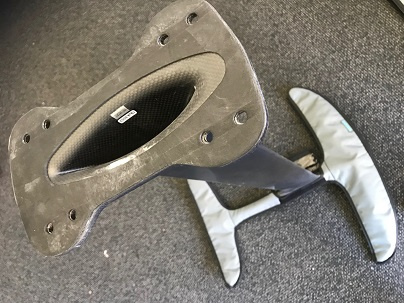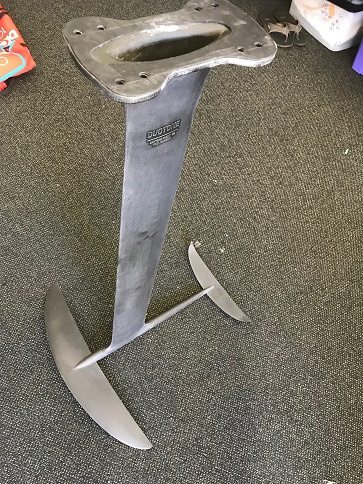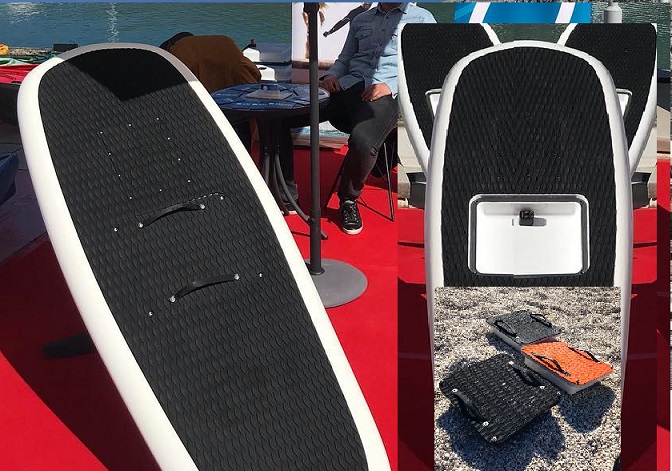I´m not sure if I understand what you mean. Do you mean to put a mark on the mold?
For the mast where you do not have the anhedral shape like the wings I think it would be easier.
I´m not sure if I understand what you mean. Do you mean to put a mark on the mold?
For the mast where you do not have the anhedral shape like the wings I think it would be easier.
When you design the wing, you should add some curvature at the trailing edge so that you can see it on the mold (and the laminated part).
If we take a cross section of your mold (top side in orange and bottom side in grey) it should look like that (at the trailing edge). You can see that I added a curvature at the trailing edge of the wing (in green). It’s up to you to choose what curvature and thickness you want depending on the 3d printer resolution, how “sharp” you want it to be (for safety and performance), etc.
Nice work on the wing mold Clarin ! what material and process did you use ? it looks like it was CNC machined on a wood board. For a 3d printed mold you can use a 0.25 mm radius on the trailing edge, and you should be able to see it depending on how you 3dprint the mold. It’s the thickness of a layer of carbon fiber or fiberglass (at around 200gr/m²), so I didn’t try to add a groove. It’s only about safety and perfomance I guess.
Hey @visor360 do you think your technique could be used to mold a hollow mast offering strength and plenty of space in the top part to welcome all the needed connectors in a waterproof environment see Wire connectors between Box and Mast - #27 by SoEFoil - Electronics (ESC, remote, batteries) - FOIL.zone ?


Yes I guess it should be possible, the only way to really know is to try. It could be too weak with this technique if you have only mechanical bond. My mast+fuselage isn’t hollow and the weight is about 2.6 kg. The height from the axis of the motor to the top of the mast is 75 cm (and the total length top to bottom is around 90 cm). You can pass the cables through 3 tubes inside the mast. Why do you want to put the connectors inside the mast ?
That is a good question: saving some room in the compartment, simplicity, extra level of waterproofness if the cables are sealed (silicon ?) at board bottom level with hanging connectors. Maybe forum users out there could see other reasons…
I’m not sure because if the area between the board and the mast is not sealed properly you will have water inside the mast ! The way I designed the board is one fully sealed box with all the electronics and the battery (under the board for safety) and a small “connection” box on the top of the board to charge the battery, etc.
I did that because I don’t plan to change the battery and to reduce cost. If you want to have a hatch and change the battery you need to make everything fully water proof (including the battery).
We could also imagine everything but the battery inside the top part of mast (mini ESC like the @nickw1881 one (106 x 54 x 26 mm) , radio, possibly with a no-pump but short water cooling loop ala LIFT/Flying Rodeo) … just saying.
Then, a DiYer would just need to concentrate on a small battery case like Sailfin Plurato does…
That would also mean only two XT connectors between board and mast. ![]()

Can anyone pitch in how many layers of carbon would be required to get this working? It’s easy enough to do with a xps foam core that you can melt away with acetone after laminating or using a core that you pull out afterwards (like filament winding mandrels) just needs a taper to it which is easy enough. I like the idea since you can machine an aluminium case for the ESC that is waterproof and have the esc in the strut. Carbon doesn’t have the best heat transfer coefficient but one could use the strut as a heatsink.
For maintenance purpose, I was thinking about an extractible ESC on rail with case as computer hard drives… … a rack connection style, no wire connected to ESC but 3 between lower part of ESC outer case and motor
Totally possible. That apd esc I will be using is compact enough to fit in the top of the strut just needs a casing around it that follows the inside of the strut.
I would be interested in trying it out. Just not sure about the laminate buildup.
Hi guys ! I have been working hard the past 3 months sorry I didn’t post anything. But I think you will like the result (I hope haha). I have redesigned the fuselage&mast and the front wing. I also improved a lot the process of making 3d printed molds. It’s much cheaper now with better result!
Nice work, I love it 
Is the mast also full carbon fiber ?
Outstanding finish quality. Looking forward to the first water tests and more information about how you achieve such results.
Do you vacuum ?
Mold life cycle: how many pieces per mold can you achieve while maintaining a good quality ?
Thanks man! Yeah it’s full carbon, and filled with a carbon fiber filler (I prefer safety). But you can make it hollow too.
you can find more details here https://www.easy3dcomposites.com/pages/efoil and here you can see the preview video https://www.easy3dcomposites.com/products/efoil
My website isn’t finished so there are maybe bugs in some pages… (it doesnt work well with internet explorer) My goal is to make everything free for efoil builders if they post a positive review and a picture to help me with the website (and I reduced all the prices by half during this time). I will help them with their build. Find solutions to their problems and share with everybody.
Yeah in the beginner course I show how I make a cheap (less than 100$) and user friendly vaccum bagging system easy3dcomposites.com Because standard vacuum bagging system can be super expensive and not easy to use… You will find all the info to make reusable 3d printed molds in the beginner course and like I said if you post a positive review with pictures I will give a full refund so it’s actually free.
Mold life cycle will depend on so many things : how well you build your mold, how “aggressive” the resin you use is, if you use the mold properly, etc. If you do 0 “maintenance” (cleaning the mold, good storage, applying some layers of release agent after each “pull”, etc.), the lifecycle will be much shorter. I haven’t done destructive tests yet (to see the maximum parts we can make)
I only used the same mold 5 times. And the surface still looks great, it didn’t feel more difficult to remove the part from the mold. So I believe you can make a lot of parts from these molds if you use it properly.
Good deal… will buy it. Hope it will save lot of my time…